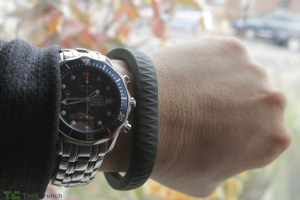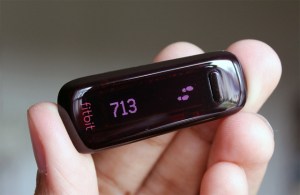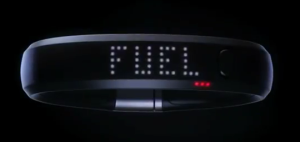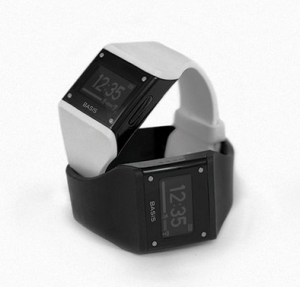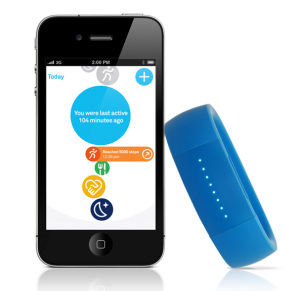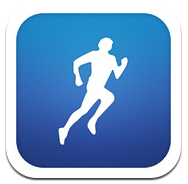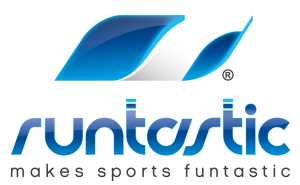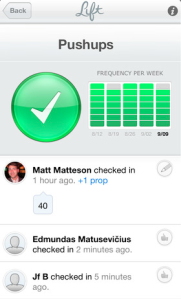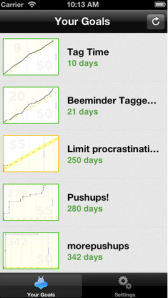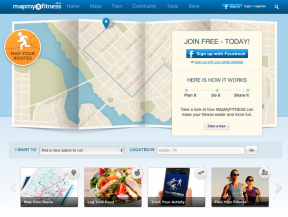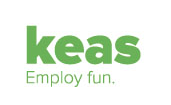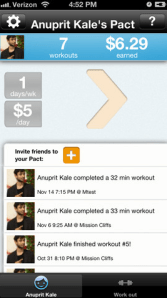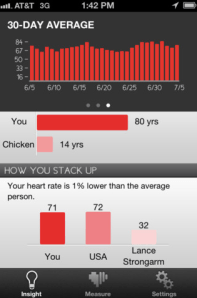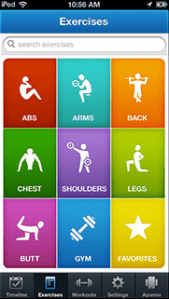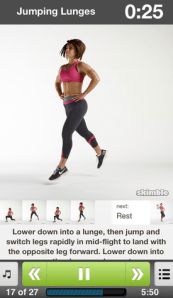The holidays wreak havoc on our bodies, with their mandatory over-indulgence in food as well as family and reminiscences. As we reflect on the year past — its victories and losses — we also begin looking ahead to the next, and in big ways or small, making plans to keep our momentum going.
For many, this involves taking health more seriously, whether it’s losing a few pounds, training for that first marathon, or just being more active. In turn, there’s been a lot of activity in the health space over the last year, as we’ve seen a number of apps and startups launch — or continue iterating — in the quest to help us make healthier choices, get in shape and conquer the world.
The health space is always in a state of transformation, but its evolution has accelerated of late, and technology is playing an increasingly vital role in this development. Improvements in sensor technology (and a reduction in the cost of production) have led to a boom in the popularity of health monitoring and tracking devices, which itself is becoming a crowded market.
Increased government involvement in health insurance and delivery (via ObamaCare), mobile technology, next-gen networks, Big Data and analytics are all having a disruptive effect on the industry. Business models have begun to change, becoming more patient-centric and outcome-focused, as risk shifts to providers.
Meanwhile, healthcare IT has been slowly moving to the cloud and upgrading its architecture to allow for more flexibility, as social tools, mobility, broadband access and wireless tech have given rise to the “health care everywhere” imperative and opened the door for greater transparency and visibility into healthcare costs. In spite of some doom and gloom from investors and the intimidating prospect of changing old, inculcated consumer (ahem, patient) behaviors, startups are still moving to take advantage.
In fact, for Quantified Self devotees, data-vores and the fitness conscious it’s a great time to be alive. Wearable health-tracking devices and health information and networking platforms are maturing, as is the technology that makes them tick, and it won’t be long before doctors are prescribing mobile health apps and devices. The FDA’s recent approval of AliveCor’s iPhone-based heart monitor is just one great example of how much there is to be excited about at the intersection of technology and health.
And for startups, there’s a lot to be excited about when deciding to build a business in this space, thanks in part to the continuing development of health-focused accelerators over the last year. Rock Health, for example, added clout and support from Kleiner and Kaiser, among others. A number of new accelerators hit the scene or turned into legitimate resources in 2012, including Startup Health, Healthbox, DreamIt Health, NY Digital Health Accelerator and Blueprint Health — to name a few. Hey, even Nike has decided to invest in the New Game.
Nonetheless, with all the excitement in the space, it can be tough to cut through the noise, keep tabs on all the options and figure out which apps and startups should matter for you. Everyone has their own individual agenda, but collectively we’re all bound to be making a few health-related resolutions in preparation for 2013 and beyond.
Without further ado, the Health Stars:
The Wearable Tech
Up is one of the members of the exciting new generation of movement and health-tracking devices. The $129 bracelet suffered from some major problems when it first debuted, but it re-emerged in November with a much-improved look and experience. You can use it to track your activity during the day, your sleep at night, as well as log food intake and mood to give you a better overall picture of your health, happiness and calorie input and output.
The device comes with about a week’s worth of battery life in a single charge, is sleek and relatively unobtrusive, insulated in rubber and is waterproof. It includes a silent alarm that will wake you in the morning at the right time and a buzzer to remind you when it’s time to get up and get moving during the day.
Most of the re-design centers around the internal hardware and keeping it immune to wear and tear. The device doesn’t come with much connection to the desktop, or an external display, so, as John wrote recently, the appeal is mostly in its simplicity and the fact that it doesn’t scream “nerd device” to all who see you wearing it. More in John’s write up here.
Fitbit is another popular wearable activity tracker that, compared to Up, is slightly more favorable in the pricing department at $99. The small, lightweight device clips onto your clothing (and is meant to be worn somewhere on the torso) or fits into an elastic armband when sleeping. It works like a charm, tracking the number of steps one takes each day, the amount of sleep one gets each night (though this is still a bit buggy), is sensitive to movement and offers a look into the number of calories burned each day.
It displays users’ activity in a personal analytics module linked to their Fitbit account, which is made easy to set up through a wireless USB dongle that can be paired with its software in a few minutes. Users can keep the dongle in a USB port of sync it with Fitbit’s new Bluetooth radio functionality. As to the data, users can view their levels of activity in graphs, food and calorie intake, and add in other data, like blood pressure mood, etc. Like Up, it’s also got a silent alarm, and at $99, it’s becoming one of the most popular of these devices. [More in Chris’ review here.]
Nike has been looking to leverage its brand recognition and massive footprint in the sports world to make waves in the fitness-tracking space with its wearable health tracker. The QS bracelet debuted in January 2012, and is now selling for $150 on Nike’s website — and, giving it a leg up over others beyond what it already had from the Nike brand — is now selling in the Apple Store across the U.S., Canada and the U.K.
Reviews of the FuelBand run the gamut, and with the trend seeming to be that, up to this point, it hasn’t been accurate enough to be used in real training and workouts, putting it more in the casual use category as a motivator for workouts and just getting off your butt. It looks great (although not unlike UP), comes with a great mobile app, and tracks whether or not you’re burning calories each day and meeting your basic fitness goals. It’s also started to gain some experimental integrations, like with Path, for example.
Nike also offers similar apps like Nike+ Running and Training Club in its growing arsenal of smartphone fitness motivators.
I say this haltingly, not having spent significant time with it yet, but Basis’ new health-tracking wrist watch is probably the one I’m most excited about. The company quickly ran through its first batch after bringing the product to market in November and has since stopped accepting new orders to concentrate on meeting early demand.
The Basis band is a bit more expensive than the aforementioned gear at $200, and the question, of course, is whether there’s enough going on to justify that higher price. But from the looks of it, there is, especially for the Quantified Self and wristwatch nerds among us. The device comes with an LCD display (sort of like Pebble’s e-ink version) that shows date and time, touch capacitive buttons, a 4-day battery life and Bluetooth support, which will be activated when the company releases its accompanying mobile apps (expected in the near future).
The device is loaded with sensors, which beyond using the accelerometer to measure sleep patterns, include an optical scanner to track blood flow (i.e. heart rate), a perspiration monitor, as well as skin and ambient temperature monitors to measure workout intensity, heat dissipation and so on. On top of that, the company offers a dashboard complete with a host of metrics, which include stuff like calories burned, steps taken, resting heart rate and hours slept and allows users to track their progress and create small, achievable goals to begin establishing healthy habits.
One of the more noteworthy aspects of Basis is that it adjusts to your daily activity (and sleep patterns) automatically, so you don’t have to mess around with different modes and settings. The idea is that it just works in the background, suggesting personalized goals and habits that you can actually meet — when you want it to. There are still more pieces to add, like integrations with other devices, an API, mobile apps (and of course wider availability), but Basis looks to have a lot going for it — at least at this early stage. [More in our review here.]
Lark was originally a sleep-monitoring device, app and coaching service that recently expanded beyond sleep to go after the broader, general wellness market. The TechCrunch Disrupt grad now combines, a nighttime and daytime wristband and iOS app to track basic fitness statistics, food eaten, sleep logged, calories burned, distance traveled, and so on. Lark CEO Julia Hu recently told TechCrunch that Lark has sold “tens of thousands” of devices, and that 73 percent of insomniacs saw an improvement after using Lark Pro for a month. The wristbands are designed by Ammunition — which also designed the Beats by Dre headphones — and through its new platform the startup is trying to move beyond its initial, core user base: Athletes.
The app and wristband combo now offer one-tap diet tracking, which allows users to tap a button to indicate they’re eating, tracking dietary info, stress and productivity data to help users make more informed decisions about their health. The platform offers personalized advice, developed in consultation with its scientific advisors, which include Stanford “neuroeconomists,” psychologists and sleep experts and so on. The “Larklife” product, which includes the two wristbands and mobile apps, will sell for $150. Lark looks great and has a lot to offer, but it does have to contend with the fact that others are offering a lot of this functionality in one device — at competitive prices.
Misfit Wearables’ Shine is another elegant-looking activity tracker that isn’t yet available but looks promising.
Amiigo, which, described in our recent coverage, is a “fitness app and lightweight plastic bracelet (with detachable shoe-clip) that can identify the type of exercise you’re doing and tell you how well you’re doing it as you’re doing it, thanks to a variety of sensors analysing how your body is responding as you run, bike, swim (yes it’s waterproof), or whatever your preferred exercise poison.”
No Gadgets Here, Just The Apps
This Android and iOS app is one of the strongest in the category of those that look to turn your smartphone into a personal trainer. RunKeeper is part motivator, part tracker and (long-term) part health graph. The app allows you to track your walks, runs, exercise bike rides, hikes, etc. by using the GPS in your phone, keeping stats on each activity, comparing those stats, setting short-term and long-term goals, offers customizable training plans, and voice coaching. The startup also aims to be a health and fitness data aggregator (or graph) and appeal to Quantified Self enthusiasts by connecting to Bluetooth and leveraging its API to integrates with Fitbit, WeightTraining.com, Fitocracy, Lose It!, Gympact and GAIN Fitness, among others.
The company just passed its 100th integration, leading in this regard. However, RunKeeper co-founder and CEO Jason Jacobs tells us there’s still a long way to go, as the category heats up and more apps and devices become available on the market.
The startup now has over 14 million users and many, he says, are looking to tie in data from other health apps to their RunKeeper accounts, especially as the company now allows them to earn credits for their workouts and apply them to corporate wellness programs, fitness games, rewards systems and so on. Usage of these integrations, Jacobs tells us, grew 825 percent year-over-year in 2012. Part of the reason Mark Zuckerberg included RunKeeper in a short list of apps that had caught his attention this year.
As to what’s next, Jacobs said that the startup will be looking to more tightly integrate the data from its partners into the core RunKeeper experience in the coming months — and to better integrate RunKeeper data into theirs — and will be announcing a number of partnerships in the next quarter as well.
Find it here.
This one may be better known to European readers, as Runtastic got its start across the pond, but it’s beginning to establish a footprint in the U.S. as well. And overall, it was a good year for the startup, which has looked to carve a name for itself in the space by becoming a full-service health and fitness platform. Traditionally, it’s been focused on tracking and coaching fitness enthusiast through outdoor recreation, allowing users to take advantage of fitness plans with voice coaching, as well as track and analyze their exercise data, monitoring speed, elevation and distance and storing that info in the cloud to measure progress against yourself and others (along with some cool “PRO” features for Android users.)
More recently, it’s expanded into “indoor” fitness as well, with motion-activated apps for activities like push ups and pull ups, and now offers a heart-monitoring app to boot. All in all, a productive 2012 for Runtastic has meant the launch of seven new apps for a total of 14 (including free and PRO/paid apps), over 12 million downloads this year alone (for over 16 million total), along with the addition of 5 million registered users on Runtastic.com, the launch of hardware in Europe (a heart rate monitor with GPS watch, armband and chest strap), integration with MyFitnessPal as a launch partner for the debut of its API, Google Earth integration and the launch of a fitness channel on YouTube. Going forward, users can expect more apps, more integrations, and the launch of its hardware in the U.S. during Q1. [More in our coverage here.]
Lift is a great-looking iPhone app that’s operating behind an ambitious goal: Improving human potential. The Obvious-incubated and now venture-backed startup wants to help you reach your goal, whether that’s getting in shape, living healthier, becoming more productive, or being more kind to animals — or your mother in law.
The app helps you break down your challenging personal goals into micro habits in order to make it easier to gain momentum and, presumably, achieve those goals. For Lift, it’s all about simplicity; while many startups and app developers say that, Lift really means it. Users create and join habits, clicking Lift’s big button if they’ve met their goal that day, and all activity is public, where users can cheerlead for their peers and receive encouragement of their own. The app pushes your accumulated data into good-looking graphs and charts, showing you how consistent you’ve been in meeting your new, positive habits.
Last week, the startup updated its app in the hopes of helping people meet their New Year’s resolutions, adding reminders (the most-requested feature), along with updating the overall user experience. In a crowded space, where companies like Basis are building some of this functionality into their wearable tech experiences, it will be more difficult for apps like Lift to stand out. However, the company recently recruited Matt Matteson, employee numero uno at Path and is backed by the guys behind Twitter, so it’s got some heavy-weight support. And focus on simplicity is a big leg-up in the data-noisy world of Quantified Self apps and devices.
Beeminder is attempting to take an evil-genius approach to motivating you to reach your goals. Namely, if you don’t stay on track towards your stated goal every day, Beeminder will charge you a predetermined amount, starting at $5, that increases each time you fall off track. The idea is that you quickly reach an amount that motivates you. Your rational, forward-thinking self is putting this restriction on your lazy, impetuous self in order to make it do the things you really want to do. Beeminder works for any quantifiable goal, like losing weight, exercising three times a week, or even productivity goals like checking things off your to-do list. It can automatically track your data from other services like Fitbit, Withings, and RunKeeper.
Beeminder is similar to StickK.com, but more data-oriented. Basing your commitment on a graph of your progress also creates flexibility (without defeating the point of a commitment contract). You can adjust your goal at any time, but updates take effect in a week, so if you want to be lazy, you have to plan ahead to be lazy.
Retrofit, which just raised $8 million led by DFJ, is a weight-loss program designed for busy people that uses a little bit of Skype, Fitbit, connected, wireless scales and live mentorship from wellness experts to help you get in shape. Retrofit allows users to set small, achievable weight loss goals — one pound per week is the typical maximum target — and private Skype video sessions with real, live fitness instructors to combat empty promises and increase healthy outcomes.
It incorporates data from your wearable health-tracking devices (like Fitbit) and wireless activity monitors and scales (which it provides in your “welcome package”) and displays that information in a way that makes it easy to consume and customizable. What sets Retrofit apart is the personalized instruction from its wellness experts, who are registered dietitians, behavior coaches, and exercise physiologists and a “maniacal” focus on helping you lose weight. Retrofit comes at a cost, though, with its starter, 10 percent weight loss program (which includes 12 expert sessions) beginning at $259/month for a year-long commitment and scaling up from there.
MapMyFitness is a well-backed conglomeration of fitness-oriented websites and apps, which allows users to track and store their running, cycling, walking and hiking activity and access a considerable database of international routes, fitness calculators, events, listings, nutrition tracking and more. Founded in 2005, MapMyFitness is one of the early movers in the space and has grown into one of the more popular fitness apps in the App Store, passing 9 million registered users and 30 million downloads (across all apps) this summer.
The company has been expanding into international markets of late (along with its offline partnerships) and recently rebuilt its portfolio of websites, updating its routes, courses, personal challenges and integrating with the latest version of Google Maps’ API. This means that users can now get real time info on weather, safer routes, directions, elevations, customer markers and traffic, on top of leaderboards, the ability to check-in at workout locations and compare progress to specific groups, be it friends, running rivals or local clubs. An oldie but a goodie.
Keas is a venture-backed social wellness platform brought to you by Adam Bosworth, a familiar name in the Health 2.0 space and one of the creators of Google Health. Keas allows companies to pick health goals and compete against each other to lose weight and get in shape, incentivized by a reward system which offers both real and virtual prizes.
The idea is to reduce the cost of healthcare plans and increase productivity in the enterprise by giving employees a wellness program that encourages participation and engagement by creating an experience that is fundamentally social and actually fun. Employees join teams of up to six people, competing for cash (or bragging rights) offered by their employers in pursuit of healthier lifestyles. One corporate client (Chilton hospital) reported that participating teams (about 40 percent of 1,300 employees) lost 1,230 pounds in a 12-week challenge. A great option for healthier workplaces.
Pack, Inc. is a website and iPhone app that aims to complement all those new health data trackers, devices and training apps with an incentive plan that adds another layer of encouragement to get you off your butt. For Pact, the key to achieving your health and fitness goals revolves around negative motivation. Rather handing out points or badges, Pact offers peer pressure and cold, hard cash as its incentive, allowing users to check in and set goals for, say, how many times they’ll hit the gym in a given week and how much they’re willing to pay if they don’t reach that goal.
If you meet your goal, you earn a cash reward, and if not, the money goes into a community pot and is doled out to those who do hit their milestones. Pact Co-founder Yifan Zhang tells us that, since the startup launched in January of last year, it’s managed to retain 50 percent of its users and has been focused on creating value for its partners. For RunKeeper for example, Pact was able to increase RunKeeper usage by 64 percent across the board and by over 520 percent for its least active users by employing its monetary reward structure.
The startup was on its way to 1 million workouts facilitated in 2012, and is getting ready to release its Android app on January 1st, just in time for those New Year’s resolutions. [Check out our coverage here.]
Along with AliveCor and Azumio, Rock Health grad Cardiio is the maker of a $5 heart rate monitoring app that requires you to touch the iPhone’s camera to capture your pulse — all you have to do is let the app take a picture of your beautiful mug. The app’s sensors attempt to pick up minute differences in the color of your face that indicate changes in heart rate. It also offers long-term tracking to see how your resting heart rate morphs over time, along with comparisons to population averages. Next, the company plans to use this technology to expand into other types of biofeedback. [More in our coverage here.]
Thanks the popularity of its biofeedback apps like Instant Heart Rate, Stress Doctor and Stress Check, this startup has seen over 30 million downloads across its iOS and Android apps. In July, it acquired SkyHealth, the makers of Fitness Buddy, one of the top-ranked paid health apps on the App Store. With the acquisition, Azumio now counts 15 health and fitness apps in its portfolio and is on a mission to create a fitness platform that gives users a complete picture of their health, spanning heart rate, stress, sleep behaviors, blood sugar levels and workout routines. With the recent addition of its Fitness Trainer app, Azumio is looking to become a mobile, adaptable personal trainer and health-tracker that allows you to reach your fitness goals without ever going to the gym. [Check out our coverage here.]
Rock Health grad Skimble has created a motivation and fitness instruction platform with “Workout Trainer” that offers hundreds of workouts, which are guided by a dynamic audio and visuals aimed at giving aspiring health nuts an easy way to exercise, regardless of how much time they have, or what equipment they have close at hand. The app looks great, and if you upgrade to the startup’s premium service, bland voice-overs are replaced by actual coaches and instructional videos — a much more rewarding and useful experience.
Users can create their own workouts, adding it to the startup’s sizable multimedia exercise library, get reminders on your phone, via email, Facebook and Twitter, and share progress with friends. The modular database is easy to navigate, the app looks good, and everything syncs with user accounts on Skimble.com, and the subscription plan is affordable at $25/year.
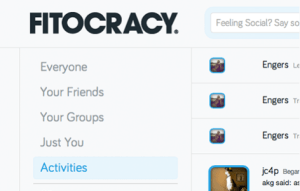 Fitocracy is a social network that aims to gamify fitness for those RPG lovers out there by awarding you with points, the ability to level-up and win badges in an attempt to encourage you to engage more consistently with your exercise routines and trips to the gym. The invite-only, free web app has you set up a profile, add a pic, your current weight (which you can keep private), and then introduces you to a status feed that shows updates and level-ups from other users, group categories where you can learn about and dig into niche fitness info, Q&As and data, forum-style. The app also includes access to public and group leaderboards, RunKeeper integration, activity trackers, which let you add sets and reps in particular categories, earn points for completing those activities and receiving real time notifications as you progress. The app currently has around 600,000 users. [Check out our coverage here.]
Fitocracy is a social network that aims to gamify fitness for those RPG lovers out there by awarding you with points, the ability to level-up and win badges in an attempt to encourage you to engage more consistently with your exercise routines and trips to the gym. The invite-only, free web app has you set up a profile, add a pic, your current weight (which you can keep private), and then introduces you to a status feed that shows updates and level-ups from other users, group categories where you can learn about and dig into niche fitness info, Q&As and data, forum-style. The app also includes access to public and group leaderboards, RunKeeper integration, activity trackers, which let you add sets and reps in particular categories, earn points for completing those activities and receiving real time notifications as you progress. The app currently has around 600,000 users. [Check out our coverage here.]
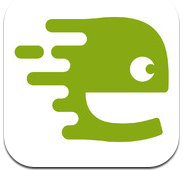 Endomondo is a veteran fitness tracking app, launching in 2008, that recently passed 10 million registered users (with 3 million+ coming in 2012 alone), putting it in the ballpark of MapMyFitness, Azumio, RunKeeper and Runtastic. The app, which is especially popular in Europe, is, as Chris wrote recently, “part personal trainer and part fitness-focused Facebook,” which runs across platforms and lets users track workouts, share with its community of exercise enthusiasts, with a focus on the social and collaborative side of fitness. [More in TC coverage here.]
Endomondo is a veteran fitness tracking app, launching in 2008, that recently passed 10 million registered users (with 3 million+ coming in 2012 alone), putting it in the ballpark of MapMyFitness, Azumio, RunKeeper and Runtastic. The app, which is especially popular in Europe, is, as Chris wrote recently, “part personal trainer and part fitness-focused Facebook,” which runs across platforms and lets users track workouts, share with its community of exercise enthusiasts, with a focus on the social and collaborative side of fitness. [More in TC coverage here.]
The Honorables
GAIN Fitness offers personal trainers, digital-style in an app that lets these coaches help you create interactive, personalized work out routines that help you through easy-to-reach fitness goals. Workouts and plans are matched to your personal fitness level, goals and available time — instantly and from the comfort of your mobile device. [See Colleen’s GAIN test drive here.]
Zombies, Run is an awesome running game that immerses you in an action-packed story (mixed with your own music) that you play while jogging in the park or running on a treadmill. Basically, zombies chase you as you run, and the faster you move and better you perform, the longer you remain free from craving brains — and that is what’s important.
JEFIT is an app that makes training routines and workout regimens that were initially only available to bodybuilders open and free to the average, non-bodybuilder, like you and me. The app lets you choose from a long list of exercises, comes with animations and how-to tips that are searchable by muscle group and available equipment. The app makes it a cinch to track your routines, rest and to sync your data with your web-based account.
Pocket Yoga is by far the best app for developing yoga skills at your own pace, in the comfort of your own home. The app includes voice instruction and visual guides, illustrated images of different poses and posture, as well as a dictionary of postures and positions that describes the benefit of each so that you know why you’re humiliating yourself with something called “the downward dog.”
Lose It! is another app that helps you shed those extra pounds by allowing you to track your food consumption and compare to previous meals, monitor nutrient-intake (protein, fat, carbs, etc.), log packaged foods through the app’s barcode scanner, and access a sizable database of both foods and activities.
MyFitnessPal offers aspiring weight-shedders a food diary, diet profile and huge database of food items to track calorie intake, along with discussion forums to ask questions of those who’ve already walked similar paths.
Weight Watchers is another oldie-but-goodie that helps you track food intake, calories logged, associate meals and particular foods to a point system that helps you gamify your diet. Weight Watchers was one of the first to do so, and it’s adapted nicely to mobile, where it now allows you to scan barcodes to see the “point value” of products while you’re at the grocery store.
HealthTap — This Eric Schmidt-backed startup is on a mission to become the go-to mobile platform that connects anyone and everyone with top doctors as well as provide free health information and answers to any health-related questions. In December, the startup launched a new health experience to help you realize your health goals and New Years resolutions. The redesign means that HealthTap users can now navigate through a wide range of health topics, discover answers and relevant info by tapping on a dynamic image of the human body, alongside getting access to interactive images, and doctor-created videos aimed at breathing new life into health information. HealthTap has been designed from the ground up to be a mobile-centric experience and its info and answers come from a network of over 30K U.S.-licensed doctors and physicians. [TechCrunch coverage.]
Looking for an alternative or riff on HealthTap? Ringadoc, which lets you pay a flat fee to instantly talk to a real doctor at any hour of the day,” with its big vision being “the frontline of primary care.” [TC coverage.]
Everest is a cool app for doing everything from setting goals and dreams, and getting in shape to learning Italian.
DietBet is similar in concept to Pact, Inc, offering a social dieting platform that asks users to make a financial commitment (i.e. put up cash) to encourage themselves and their friends to hit their weight loss targets. Users create teams that compete against each other, with the person who loses four percent of their starting weight taking the pot (or total money pledged). DietBet verifies weight loss through photos and algorithmic auditing.
HealthRally is another “crowdmotivator” platform that leverages peer pressure and real, live rewards to help you get healthy. Users can enlist friends and family to rally behind them as supporters, with your cheerleading squad pitching in to pay for a new iPad or some other sweet reward to keep you on track. [Check out our coverage here.]
Beyond Fitness: 25 Awesome HealthTech Startups To Keep An Eye On
Sherpaa — Sherpaa wants to help businesses reduce the amount of money they spend on health insurance not by reducing coverage or making plans more expensive, but by essentially becoming a healthcare consultancy. Sherpaa attempts to help businesses spend their money more effectively on both insurance and usage by getting to know their individual needs. The startup then recommends the right health plan for the company and gives employees 24/7 email and phone access to its hired doctors. It doesn’t replace health insurance, just intends to maximize it; Sherpaa gets no referral fees, nor does it charge physicians in its network or take money from insurance companies. Instead, the startup charges companies $50 per employee. [TC coverage here.]
Practice Fusion — Since launching in 2007, this startup has been on a mission to help the U.S. health system digitize its medical records. Practice Fusion offers a free, web-based Electronic Medical Records system that includes charting, ePrescribing, billing, support and scheduling for doctors and personal health records for patients.
Growth was slow at first thanks to the industry’s mistrust of putting health data in the cloud, 2009’s economic stimulus package included a number of incentives to encourage doctors to go digital. Since then, Practice Fusion has blown up, raising a total of $70 million from a laundry list of investors, and over the last year, has doubled its patient community to 52 million, while 150K physicians and practice managers now use its system. In a few short years, Practice Fusion has become the EMR startup of record. [TC coverage here.]
Drchrono — This startup is extending the headway Practice Fusion has made in EMRs by building a medical platform around the mobile experience. Basically, Drchrono is bringing Personal Health Records and a whole bunch more except to the iPad in an effort to simplify the lives of doctors on the go. [TechCrunch coverage.]
Simplee — This startup may have the most staying power of the many businesses that have emerged over the last two years to become the “Mint.com for tracking healthcare expenses.” Although Cake Health and a few more will obviously have something to say about that. [TC coverage.]
Doximity and QuantiaMD — To drastically oversimplify for the sake of brevity, these two startups are both trying to create the LinkedIn for doctors. (Along with Sermo and others.) Both are well-funded having raised about $27 million in total funding (each) — and one (or both) of them will become the true professional networking and collaboration platform for the medical community. There are some important differences, more on that for Doximity here and QuantiaMD here.
MotherKnows — A full-service platform that allows parents to manage their children’s health and healthcare. [TC coverage.]
LumoBack — A smartphone app and device that you wear around your waist designed to help improve your posture. A child of the Quantified Self movement, the device monitors your activity, movement and posture and provides feedback via its apps for iOS. Developed by smart sensor maker, the SF-based LUMO BodyTech, the device found early backing on Kickstarter, where it doubled its $100K funding goal and has since found backing from Eric Schmidt, Jerry Yang and more. [TC coverage here.]
Beyond Lucid Technologies — An IT firm that is making mission-critical, mobile software for First Responders. [More here.]
Aidin — This venture-backed startup is on a mission to help patients find better continuing care after they leave the hospital, particularly for “post-acute care” — or the care one receives when rehabbing from a serious illness, injury or from surgery. [TC coverage here.]
CarePlanners — This New York-based startup wants to be the “AAA for healthcare,” offering online tools to help users coordinate senior care services, create a health plan around a new diagnosis, resolve billing or insurance problems, etc. The startup employs consultants with a range of expertise, from nurses and social workers to healthcare advocates and Medicare experts, which collectively create a marketplace for healthcare consulting that focuses on personalized care from real people. [TC coverage.]
Eligible — This Y Combinator and Rock Health-incubated business is on a mission to become the “Stripe for healthcare transactions,” enabling developers and insurance providers to access a modern, standardized set of APIs to make healthcare data and patient info more accessible. While this may seem an obscure part of healthcare IT, the startup is growing fast and is already making money, processing 8,000 eligibility transactions per day at five cents per transaction. From our recent coverage:
“In the same way Stripe offers developer-friendly technology to simplify the complex and obscure process of integrating payment processing into apps and websites, Eligible wants to build the first modern API that allows developers to easily exchange health data — and make money while doing it. Developers can integrate Eligible to increase both traction and revenue through these eligibility queries, patient information queries, etc.”
NatureBox — Looking to create a Trader Joe’s for the Web — or a Birchbox for organic foods — NatureBox distributes its own brand of nutritionist-approved health foods, sending them to subscribers in a grab-box to take the hassle and guesswork out of buying health snack foods. Like TOMS Shoes, for every box that the company delivers, it donates a meal to feed the hungry in the U.S. through partner organizations. [Coverage here.]
Omada Health — In December, this San Francisco-based, Rock Health-incubated startup launched what it calls the “first-ever online diabetes prevention program for the general public.” Prevent, the startup’s flagship product, is a 16-week program that offers an interactive, web-based curriculum, coaching, digital tracking tools and social support to help people at risk of developing diabetes create healthier lifestyles. Current estimates show that behavioral change programs like this for diabetes and prediabetes could save the U.S. up to $191 billion over the next decade, and Obamacare is poised to make sure programs like it are covered by Medicare. Huge. [TC coverage here.]
Glooko — A digital logbook for those with diabetes or for anyone who regularly checks their blood sugar levels, which is differentiating itself from the pack of similar apps by attempting to become agnostic to glucose meters. The startup/app now supports 17 different meters, allowing patients to connect their $40 Glooko cable to their meter and a smartphone to download all their readings with a few clicks. [TC coverage.]
CareZone — This Seattle-based startup is building a private, secure online service that allows individuals and families to better take care of their loved ones. The startup is co-founded by the former President and CEO of Sun Microsystems and in May secured $13 million in series A financing from NEA and Catamount. [Our most recent coverage here.]
Zipongo — A mix of Mint.com and Groupon for healthy living, this awesome startup (and current member of Rock Health’s incubator) wants to offer personalized discounts and coupons for healthy foods at any of your local grocery stores. Zipongo wants to make healthy eating — and buying “organic” — something that everyone can afford and download to their grocery store’s club card. Next, the startup wants to offer personalized recipes and meal plans based on you (or your family’s) health needs, lifestyle and preferences. [TC coverage here.]
Fig and HealthRageous — A new mobile, personalized wellness guide and a platform that helps individuals, employers and health providers to prevent and manage chronic health conditions by collecting biometric data from users various health-tracking devices combined with personal preferences and health info to help set goals, action plans and overcome health problems — respectively. [TC coverage of Healthrageous here.]
QxMD — This is a great one for doctors. Frustrated by having to use his BlackBerry while at the hospital (which lacked the software he needed), in 2008 practicing physician Daniel Schwartz and co-founder Chan Kruse (a former fuel cell engineer) set out to create mobile apps to help doctors do their jobs better. After launching a medical calculator and decision support engine, a guide to learning to read ECGs and a rapid reference for pediatric patients in emergent or critical care environments, the team created its newest app “Read” to be a personalized medical journal for doctors … Flipboard meets PubMed.
The app gives doctors (and anyone in the medical community) a singe resource to discover new research, read topic reviews and search PubMed (which includes 22 million-odd citations for biomedical literature from MEDLINE, life science journals, and online books) in a way that’s personalized and formatted specifically for them — and their iPad. The founders just recently launched support for third-party integration — meaning that, as scrutiny over the quality and accuracy of medical apps increases, it’s becoming important to include detailed references in mobile apps — so Read now makes it simple to provide this. Instead of linking to a resource on the Web, Read allows developers to offer access to full-text, scientific research articles (PDFs) with one line of code. Obscure, but awesome.
BetterDoctor — OpenTable for doctors. [TechCrunch coverage.]
Avado — A “GPS for healthcare,” Avado offers a Patient Relationship Management system to provide health pros with the collaborative tools they need to provide care that is individual and personalized. [TC coverage.]
Venio and Nutritionix — Two cool, related but unaffiliated startups to check out. Venio is an app that lets you set dietary restrictions and then provides you with a personalized set of meals depending on time of day, etc., culling its meals from food bloggers and trustworthy content sources. Meanwhile, Nutritionix is trying to build a public, searchable nutrition database for nutrition info from restaurants and packaged and common foods. The company just beta launched its API, which aims to offer developers the opportunity to integrate nutrition info into their apps.
My Last Cigarette — One (unfortunately) close to Jordan and my heart, helping smokers quit by mapping out changes in their health as they quit.
Special mentions also to TechStars alum EveryMove, which raised a $2.6 million series A round from a bunch of quality investors for its interactive web and mobile platform that allows you to connect and organize health and fitness activities “while turning lifestyle actions into rewards and incentives within their health plans.”
And CRV and Keith Rabois-backed Breakthrough, which offers “an easy and private way for anyone and everyone to connect with mental health professionals via email or a HIPAA-compliant video platform on the Web.” [More here.]
There also seems to be big potential for Sano Intelligence, a Rock Health startup currently in stealth, which is creating an “API for the bloodstream” and, by employing its mobile sensor system, is on a mission to provide deep insight into our metabolic data, letting patients, doctors, insurers and developers use that info to improve our health. More on them soon.

